Related Research Articles

Maligne Lake is a lake in Jasper National Park, Alberta, Canada. The lake is famed for the colour of its azure water, the surrounding peaks, the three glaciers visible from the lake, and Spirit Island, a frequently and very famously photographed islet. The lake is located 44 km (27 mi) south of Jasper town, and is accessible by motor vehicle, including shuttle buses from Jasper. Boat tours run to Spirit Island in the spring to autumn season. The 44 km Skyline Trail, Jasper's most popular, highest and above treeline, multi-day hike, begins at Maligne Lake and finishes near the town of Jasper. Other popular day hikes include the Opal Hills and Bald Hills loops. Winter activities include cross-country skiing and snowboarding.
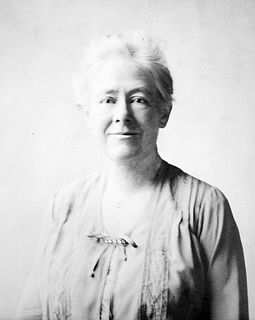
Mary Morris Vaux Walcott was an American artist and naturalist known for her watercolor paintings of wildflowers. She has been called the "Audubon of Botany."

John Muirhead Macfarlane FRSE LLD was a Scottish botanist.
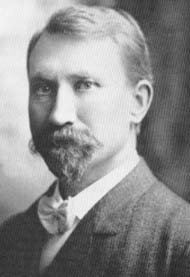
Per Axel Rydberg was a Swedish-born, American botanist who was the first curator of the New York Botanical Garden Herbarium.

Arthur Oliver Wheeler was born in Ireland and immigrated to Canada in 1876 at the age of 16. He became a land surveyor and surveyed large areas of western Canada, including photo-topographical surveys of the Selkirk Mountains and the British Columbia-Alberta boundary along the continental divide through the Canadian Rockies. In 1906, he and journalist Elizabeth Parker were the principal founders of the Alpine Club of Canada (ACC). He was its first president, from 1906 to 1910, and editor of the Canadian Alpine Journal from 1907 to 1930. He remained Honorary President of the ACC from 1926 until his death in 1945. The Arthur O. Wheeler hut of the ACC is named after him.

Allium cernuum, known as nodding onion or lady's leek, is a perennial plant in the genus Allium. It grows in dry woods, rock outcroppings, and prairies. It has been reported from much of the United States, Canada and Mexico including in the Appalachian Mountains from Alabama to New York State, the Great Lakes Region, the Ohio and Tennessee River Valleys, the Ozarks of Arkansas and Missouri, and the Rocky and Cascade Mountains of the West, from Mexico to Washington. It has not been reported from California, Nevada, Florida, Louisiana, Mississippi, New Jersey, Delaware, New England, or much of the Great Plains. In Canada, it grows from Ontario to British Columbia.
The native flora of the United States includes about 17,000 species of vascular plants, plus tens of thousands of additional species of other plants and plant-like organisms such as algae, lichens and other fungi, and mosses. About 3,800 additional non-native species of vascular plants are recorded as established outside of cultivation in the U.S., as well as a much smaller number of non-native non-vascular plants and plant relatives. The United States possesses one of the most diverse temperate floras in the world, comparable only to that of China.

Edwin Percy Phillips was a South African botanist and taxonomist, noted for his monumental work The Genera of South African Flowering Plants first published in 1926.
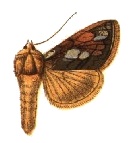
Plusia putnami, the Lempke's gold spot or Putnam's looper moth, is a species of moth of the family Noctuidae. It is found in the Palearctic realm, from Japan and eastern Siberia to Fennoscandia, Great Britain, and France. In North America, it ranges from Newfoundland and Labrador to central Alaska and the interior of British Columbia, south to Pennsylvania, Washington, north-eastern California, and in the Rocky Mountains to Utah and Colorado.
Edith Layard Stephens (1884-1966) was a South African botanist, a leading authority on algae and fungi, particularly edible and poisonous mushrooms.

Samson Beaver was the son of Job Beaver, a guide and trail setter of the late 19th and early 20th century. Both were members of the Stoney First Nation and worked in the Rocky Mountains of Canada. Job Beaver's contributions to exploration of the Rockies is recorded in Job Pass, Job Creek and other locales. As a boy of fourteen, Samson accompanied his father on a trip to the lake they called Chaba Imne. Sixteen years later, in 1907, Samson met Mary Schäffer, who had just failed in an attempt to find the route to a reputed large lake high in the mountains between Lake Louise and Jasper. Samson sketched a map showing the route to Chaba Imne. The following year Schäffer returned with her friend Mary Adams, guides Sid Unwin and Billy Warren. Using the map provided by Beaver, they found the lake, and explored it by raft. The lake is now known as Maligne Lake.
Ellen Wright Blackwell was a writer and botanist who made a lasting impact on the field of botany in New Zealand. She was born in Northampton, Northamptonshire, England on 7 October 1864.

The Illecillewaet Glacier is a glacier in British Columbia, Canada. It is located inside Glacier National Park in the Selkirk Mountains, a sub-range of the Columbia Mountains. After the construction of the Canadian Pacific Railway (CPR) near the glacier’s terminus, and the building of a hotel nearby, the glacier became a prominent tourist destination in the Canadian west. Easily accessible by road and railway, it is one of the most-studied glaciers in North America. Its retreat over the last one hundred years has been extensively documented.
The Cresson Traveling Scholarship, also known as the William Emlen Cresson Memorial Traveling Scholarship, is a two-year scholarship for foreign travel and/or study awarded annually to art students at the Pennsylvania Academy of the Fine Arts in Philadelphia, Pennsylvania.
Ida Augusta Keller was an American plant physiologist and teacher in Philadelphia.

Arnica louiseana is a Canadian species of arnica in the sunflower family, known by the common name Lake Louise arnica or snow arnica. It is native to the Canadian Rockies in Alberta and British Columbia, and named for Lake Louise in Banff National Park.
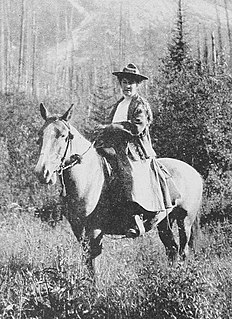
Mary Schäffer Warren (1861–1939) was an American-Canadian naturalist, illustrator, photographer, and writer. She was known for her experiences in the Canadian Rockies in the early 20th century.

Charles Schäffer was an American physician and botanist from Philadelphia, Pennsylvania. His father, Charles Schäffer, was a wholesale druggist and his mother was Priscilla Morgan, daughter of Stacey K. Potts, an old Philadelphia merchant. His early education was received from a private tutor, who prepared him for the University of Pennsylvania where he graduated in medicine in 1859. He served in the Chester Military Hospital in 1863 and was attending physician at the Mission Hospital and Dispensary from 1874 until its close in 1880. He became interested in the flora of Philadelphia and vicinity and later extended his collecting trips to the Selkirk Mountains of British Columbia amassing a collection of photographs and plants of that region.

Abraham Mountain is a 2,820-metre (9,250-foot) mountain summit located in the North Saskatchewan River valley of the Canadian Rockies of Alberta, Canada. Its nearest higher peak is Allstones Peak, 2.0 km (1.2 mi) to the west. Abraham Mountain can be seen from David Thompson Highway and Abraham Lake. Precipitation runoff from Abraham Mountain drains east into Abraham Lake.
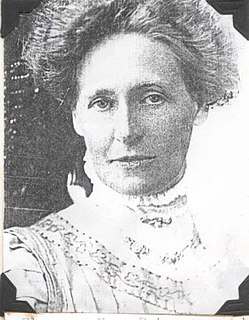
Florence Mary Paterson, née Hallack, also known as Mrs. T.V. Paterson, was a South African plant collector. Her specimens are kept in the herbarium of Albany Museum and the Bolus Herbarium of the University of Cape Town. She is honored in the plant name patersoniae and genus name Neopatersonia.
References
| Wikispecies has information related to Edith May Farr . |
- ↑ "Farr, Edith May (1864-1956)". Global Plants. JSTOR. Retrieved 10 August 2018.
- ↑ Creese, Mary R. S. (2010). Ladies in the laboratory III : South African, Australian, New Zealand, and Canadian women in science : nineteenth and early twentieth centuries : a survey of their contributions. Creese, Thomas M. Lanham, Md.: Scarecrow Press. pp. 160–161. ISBN 978-0-8108-7289-9. OCLC 659564120.
- ↑ Pringle, James S. (July–September 1995). "The History of the Exploration of the Vascular Flora of Canada". The Canadian Field-Naturalist. 109 (3): 291–356. Retrieved 10 August 2018.
Mention should, however, be made of Edith May Farr (1864-1956) of Philadelphia, who published on the plants of southern British Columbia and Alberta from 1904 to 1906, including a list of the plants of the Selkirk Range and the southern Canadian Rockies based on her collections (Farr 1907). Arnica louiseana Farr, a distinctive species with nodding flower-heads, named for Lake Louise, Alberta, was described in one of these papers (Farr 1906) and remains generally accepted as a species.
- ↑ Skidmore, Colleen (2017). Searching for Mary Schäffer: Women Wilderness Photography. University of Alberta. ISBN 978-1-77212-298-5 . Retrieved 3 August 2020.
- ↑ IPNI. Farr.